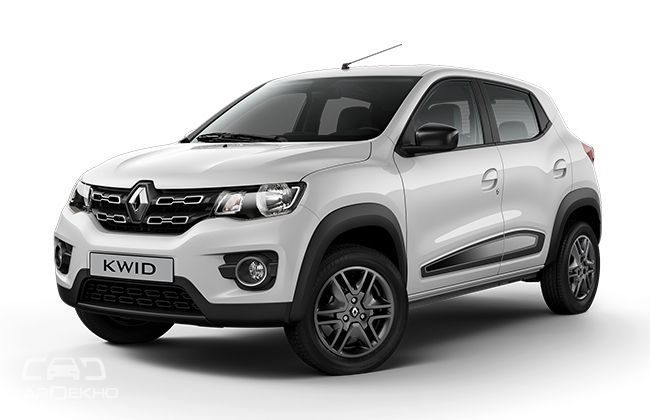Renault Kwid India-Spec Vs Brazil-Spec: What's Different?
Modified On Jun 13, 2017 11:40 AM By Raunak
- 1 Comments
- Write a comment
Subtle differences in the hatchback sold in Brazil makes it a relatively more premium as well as a safer product compared to the Kwid sold here

(In Picture: Brazil-spec Kwid)
The Kwid nameplate from Renault now has a second manufacturing base - Brazil. Until now, the budget hatchback was only produced in India. The Latin American version of the Renault Kwid was unveiled last week at the 2017 Buenos Aires Motor Show.

(In Picture: Brazil-spec Kwid)
Here’s a little history lesson. The Kwid made its world premier in India back in 2015. With a shockingly low price of Rs 2.56 lakh, the Kwid became an overnight sensation and embossed Renault’s name as a major player in the entry-level car segment.

However, the Global NCAP (New Car Assessment Program) blew the whistle on the Kwid last year when it crash-tested the India-made hatchback. The crash test scores were nothing to speak of (similar to the test scores of its primary rivals - the Maruti Suzuki Alto 800 and the Hyundai Eon). Later that year, Renault made a few changes to the structure of the hatchback and at a later test, the Kwid managed to score a one-star rating.

After the test, the Global NCAP had stated that the structural reinforcements were implemented only on the driver side and that there were no reinforcements made on the passenger side of the updated Kwid.

The Brazilian Kwid, on the other hand, features as many as four airbags (dual-front and front side thorax airbags) along with child seat anchorages (two ISOFIX anchorages) and ABS with EBD as standard.

The Brazil-spec Kwid will soon undergo crash tests at the hands of the Latin NCAP. We are quite confident that the Brazilian version will fare better than the hatchback made in India. Stay tuned to CarDekho for the results of the test!

(In Picture: Passenger airbag of the Brazil-spec Kwid)
The Kwid in Brazil weighs nearly 100 kg more than the hatchback produced here. Brazil will only get the 1.0-litre version, which weighs 790kg. The equivalent Indian version tips the scale at 699kg! The reason for the heavier kerb weight could be the outcome of the structural reinforcements and the additional goodies that it is offered with.

On the whole, the Brazil-spec Kwid looks identical to the model sold here, but there are noticeable differences. To begin with, it rides on fatter and wider tyres (165/70 cross-section) wrapped around larger 14-inch alloy wheels with a gunmetal finish. The Indian version comes with 13-inch steel wheels shod with 155/80 cross-section tyres. Renault should have at least offered the 14-inch wheels with the Kwid 1.0L in the country.

The highlight of the Brazil-spec Kwid’s interior is Renault’s 7.0-inch MediaNav touchscreen infotainment system. The same unit is offered here as well. But there is a slight difference with the system offered in Brazil.

They get the latest version of the infotainment system that is currently only available with te the Duster/Terrano and Lodgy in India. It additionally comes with a rearview camera support along with Eco Scoring and Eco Coaching function as well.

The Brazil-spec model gets a conventional instrument cluster with a three-dial setup, unlike the all-digital setup that is offered in our country as standard.

The three-dial setup not only looks better but has the added advantage of a tachometer, which is not offered in the Indian version at all. There’s a larger MID (multi-information display) screen as well.

While the Brazil-spec Kwid’s steering wheel is identical, it does get additional piano black inserts on the sides. It does miss out on the partial leather wrapping though. There are piano black inserts on the centre console as well around the gearshift lever.

(In Picture: Brazil-spec Kwid)
The controls for manual air conditioning in the Brazilian version is placed in the lower section of the centre console, where the India-spec Kwid houses power window and AMT gearshift controls. In the Brazil-spec Kwid, these controls can be the infotainment unit.

The central AC vents of the Latin American Kwid look solid compared to the flimsy and much criticised shut-open type vents offered here. Further, the control knobs for central locking, power windows, AC controls appear far more premium.

Besides these, there are others details that make the Brazilian hatchback more premium such as the electrically adjustable and foldable outside rearview mirrors (ORVM), electric boot release, rear defogger with wash and wipe function among others.

The central console extends till the rear footwell and the boot has full carpet covering as opposed to the India-spec Kwid, which has visible body panels. However, compared to the made in India Kwid, the boot space is smaller by 10-litres.

The upholstery on offer clearly looks upmarket and the rear seats feature retractable seatbelts and three individual and adjustable rear headrests.

The Indian version does not get retractable seatbelts and comes with fixed headrests.

Mechanically, the Kwid in Brazil is powered by Renault's 1.0-litre, 3-cylinder SCe petrol engine which is the same engine under the bonnet of the Kwid 1.0L sold here. The 5-speed manual transmission is the same as well. At 67Ps and 92Nm, the power and torque figures are also identical. The Brazil-spec Kwid is also expected to come with the EasyR 5-speed AMT (automated manual transmission).

Now, let us talk about the price. The base version of the Kwid in Brazil starts at R $29,990 and goes up to R $39,990 (approximately Rs 5.85 - 7.81 lakh). The Kwid 1.0-litre in India is priced in the range of Rs 3.54 - 4.56 lakh (ex-showroom, New Delhi). That’s a price difference of over Rs 2 lakh! Like the Brazilian market, would you be willing to spend more for a safer car with additional features? Do let us know.
Must See: 7 New Graphic Designs For Renault Kwid Live For More Edition
Read More on : Renault KWID Automatic















